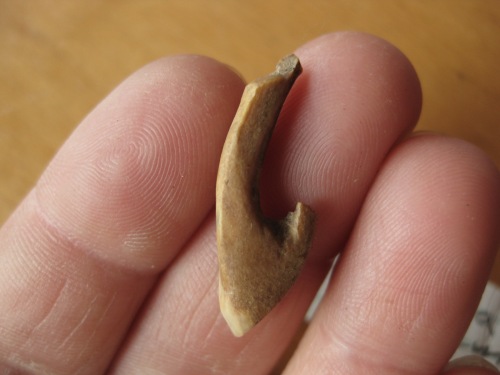
Unusual fish hook fashioned from a canine tooth. Ca. 3000 years old, Burnaby Narrows, Haida Gwaii, 2012. Photo by Jenny Cohen.
Quick note to say there are two forthcoming public talks that might be of interest to residents of Vancouver or Victoria. The Vancouver one is by Dr. Ken Ames, Professor Emeritus at Portland State University, speaking at UBC on Thursday October 18th at 11.30. The Victoria one is by yours truly, speaking to the Archaeological Society of BC on Tuesday October 16th at 7.30. Details are below.
Dr. Ames, the unofficial Dean of NW Coast Archaeology, will be speaking to the topic “Entangled in the Fur Trade: The Archaeology of Contact on the Lower Columbia River”. You can view a poster and abstract for the event here. Incidentally, he has an old-school web page with tons of his extensive and highly influential publications available for download. The talk is at 11.30 in ANSO 134. I teach on Thursdays over here, or else I’d schlepp over there.
My talk is on preliminary results of the 2012 field season in Haida Gwaii. It’ll be spoken in the “Royal We,” in the usual ASBC place at the Pacific Forestry Centre, 506 West Burnside Road. map. It’s free and open to the public, as always. The overview is as follows:
The 2012 archaeological research program in Gwaii Haanas had several quite distinct components. In this talk I will review new finds from the 10,700 year old Kilgii Gwaay wet site, where favourable preservation of organic artifacts allows accurate assessment of early period technological capacities. I will also review new finds from the Burnaby Narrows area, where excavation on a series of sites on relict shorelines is helping to fill in gaps in the very poorly known 5000 to 2000 year old time period in Haida Gwaii. Excavation in 2012 focused on testing different terrace heights and establishing chronology, but a number of interesting artifacts were found, including decorated bone, a large chalcedony assemblage, and what appears to be an early appearance of ground stone celts in the middle Holocene period.”


Wish I could be there. Too bad I’m not in Victoria.
LikeLike
We REALLY need to get together and chat about the ‘very poorly known 5000 to 2000 year old time period in Haida Gwaii’ – I’ve got some interesting stuff for you 🙂
Give me a call the next time you’re up!
LikeLike
Hi Drew, hope all is well with you.
Jo where are you? Maybe email some hints or post them here? Maybe we can remove the “poorly” from “very poorly known.”
LikeLike
Or maybe we can at least add “southern” before Haida Gwaii. Perhaps the north is becoming less poorly known? I too would love to hear more about this!
LikeLike
Hi Q,
Sorry i cant make it to Vic for your talk. Please keep me posted on the early celts. Earlier than the ones from Blue Jackets Creek?
Jesse
LikeLike
Hi Jesse,
It’s a little hard to disentangle the data from Blue Jackets. Superficially, going on the photocopied images in Severs 1974 Plate 6 (CAA Bulletin), say, they are similar in shape and general appearance. But figuring out the relationship between Blue Jackets celts and the absolute dates from that site is not something I have nailed down yet.
One of the pieces is close to a date of 4330 14cBP. The others are on a higher marine terrace and should be older, but we are waiting for dates so can’t say much, but I would definitely not expect them to be older than about 5500 14cBP, let’s say.
I’d really like you to look at the raw material sometime – even just to eyeball it – they are different one to another but include a sort of creamy white siltstone like material as well as very pale seafoam green and some coarser material as well. You have a name and description of the Rupert celt material which I don’t have at hand but it resonated with what we have here. Definitely not typical examples of, in my view, that central coast “greenstone” which you say is chlorite, right?
LikeLike
Hi Q
I would love to take a closer look at them sometime – NIR or eyeball technique. Indeed the central coast celts (greenstone ones) are made of a chlorite rock. A good number from the North Coast and adjacent Northern Interior are made of a rock called smaradigite (a type ‘amphibolite’). All of Gary C’s celts from MchNicol Creek were made of this. To me, they looked like a very dark green chert – it has a chonchoidal fracture. Your pics didn’t really jump out to me as something i recognized immediately.
J
LikeLike